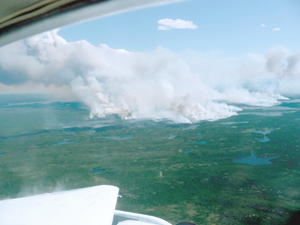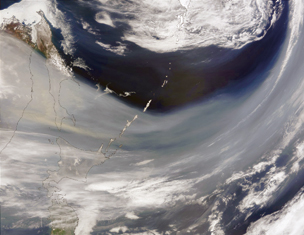Picking the "Low Hanging Fruit"
of Arctic Climate Change
Dubbed POLARCAT for short, it was the most ambitious effort ever undertaken to measure “short-lived” airborne pollutants flowing into the Arctic and determine how they contribute in the near term to the dramatic changes underway in the vast, climate-sensitive region. POLARCAT served as the coordinating umbrella for a host of individual but related research efforts undertaken by scientists from 20 countries.
The NASA DC-8 approaches one of the many active forest fires that were sampled in northern Saskatchewan June-July 2008. |
Black carbon may account for as much as 30 percent of Arctic warming to date, according to recent estimates. Black carbon can warm the surrounding air and, when deposited on ice and snow, absorb solar energy and add to the melting process.
POLARCAT was conducted most intensively during two, three-week periods in the spring and summer of 2008 in which scientists, including researchers from UNH, analyzed the movement and composition of polluted air masses flowing into the Arctic region. The field effort ended last July and researchers have been analyzing their data this past year.
In early June, UNH hosted a four-day data workshop where scientists shared their collective results for the first time, and discussed the next scientific steps and possible policy implications.
“This is a very perilous time for the Arctic and everyone is concerned about doing something to address the situation,” says atmospheric chemist Jack Dibb of the EOS Complex Systems Research Center. Dibb, along with CSRC colleague Eric Scheuer, was on board NASA’s DC-8 “flying laboratory” last spring and summer sampling plumes of polluted air being transported into the Arctic from lower latitudes and from unexpectedly large biomass burning in the region itself, including large-scale agricultural fires in Russia, Kazakhstan, China, Canada, and the Ukraine.
While there is a sense of urgency to the situation, the complexities facing scientists and, ultimately, governments and policymakers, are daunting. And although there is momentum building to “buy some time” by controlling short-lived pollutants, the science with regard to how these pollutants, and black carbon in particular, are affecting the rate of change in the region isn’t in yet. (Controlling carbon dioxide emissions is vastly more complicated, potentially costly, and because of its atmospheric lifetime it takes much longer for the benefits of reductions to be observed.)
All of which makes it difficult to move forward. For example, there is some reluctance on the part of the scientific community to recommend that society pour a lot of time and money into reducing black carbon emissions only to discover that some other action – reducing methane, say – would have provided more bang for the buck. Moreover, says Dibb, “And you certainly don’t want to do something that will have the exact opposite effect of what you set out to do.”
A river of smoke almost 937 miles wide stretches more than 1,375 miles over the Pacific Ocean from fires in eastern and southern Russia in this Moderate Resolution Imaging Spectroradiometer (MODIS) image from NASA’s Terra satellite on May 7, 2003. Plumes of similar scale and impact were seen during POLARCAT. Image courtesy of NASA Earth Observatory |
Indeed, at the data workshop scientists discussed one modeling study that suggests controlling black carbon emissions might actually backfire and lead to further warming – although most modeling studies indicate that reductions of sources such as diesel engines will definitely have a positive effect on climate.
Among the POLARCAT scientists it was generally agreed that current models lack the necessary robustness to nail down the science and help with effective policymaking. Moreover, there is still a lack of adequate field data that would allow modelers to “constrain” their models and make them better mirror reality.
For example, models are currently unable to accurately show how much black carbon might be getting “scavenged” out of polluted air masses and deposited on snow and ice, perhaps adding to the overall melting process. And, as Dibb and others point out, while replacing billions of primitive cookstoves in India, for example, would definitely improve people’s lives by eliminating the sooty emissions, “whether or not it shows up as a reduction in carbon in the Arctic is not at all clear,” Dibb says.
But short-lived pollutants are fast becoming the “low-hanging fruit” that, when plucked, might forestall some aspects of climate change. The eight-nation Arctic Council recently agreed to jointly undertake efforts to reduce emissions of black carbon, ozone precursors, and methane in order to slow climate change and ice melt in the Arctic.
“It’s impossible to look at the speed of Arctic change and not wonder about what can possibly be done to slow the melting,” says Ellen Baum, senior scientist for the Clean Air Task Force, which helped organize the POLARCAT workshop. She adds, “For that reason, reducing short-lived pollutants that have global and Arctic-specific impacts rises to the top, and seems to be one of the only options where benefits can be seen in a timeframe that matters.”
And says workshop attendee Catherine Witherspoon, a program consultant for ClimateWorks Foundation (an international philanthropic network “dedicated to achieving low-carbon prosperity”), “It’s fair to say that nobody has the definitive answer about when we’ll reach irreversible tipping points, but I think a reasonable case can be made to act on short-lived pollutants if those are 'no regrets’ actions because we’ll be getting health benefits at the same time.”
According to Daniel Jacob of Harvard, who served as lead scientist on the NASA DC-8 portion of POLARCAT, there is an increasing push to integrate climate change and air quality/health objectives in the design of environmental policy. And, he says with respect to focusing on black carbon, the Arctic could provide a “backdoor way” of combining the public health and climate change aspects of the debate.
Jacob notes further that POLARCAT data show the sources contributing to pollution in the Arctic are much more diverse than previously thought. “And what that means, from the standpoint of building environmental policy, is that every large mid-latitude nation is contributing and so it becomes more of a collective endeavor – all the industrial countries in the northern mid-latitudes have to pitch in” to help solve the global problem.


